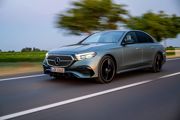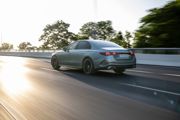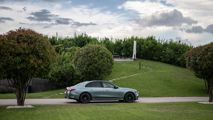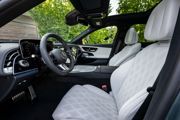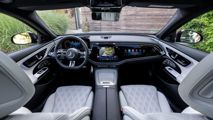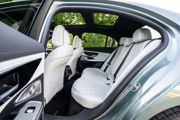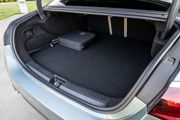Review
You probably thought there weren’t many more gadgets or gizmos that could be crammed into a car - short of the ability to fully self-drive - but Mercedes-Benz, ever the innovator, has developed a new E-Class that takes in-car technology to new heights.
The E-Class has a rich history as Mercedes’ mid-size three-box saloon. Its roots can be traced back 70 years and the same DNA that made it a benchmark for robustness and comfort back then can be found in the model we’re testing today.
What sets the E-Class apart from its forefathers is its digital evolution. The dashboard is now dominated by a giant touchscreen, there’s a new advanced lane change assist system and a camera that enables on-board video conferencing.
At its core, the car remains a comfort-focused executive express. The cabin is whisper quiet, the ride soft and supple and the exterior styling as understated and elegant as you’d expect.
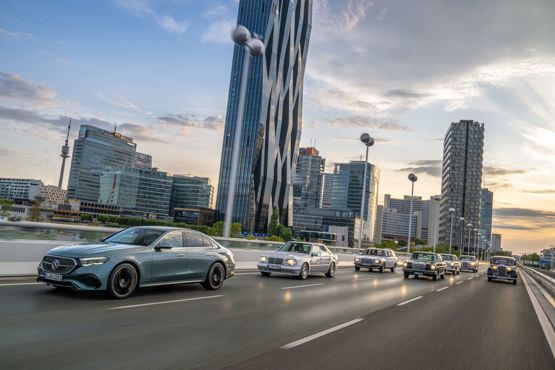
It may seem controversial to launch an all-new car in 2023 with no electric powertrain, but Mercedes said this will be the last E-Class to be fuelled by petrol or diesel. There is, of course, the EQE which already occupies the same segment. A Mercedes engineer told us the reason there’s no electric E-Class is simply because they didn’t want to compromise any part of the car in a bid to integrate a range of different powertrains.
For fleet customers, the plug-in hybrid E300e has been given a significant upgrade when compared to its predecessor. The battery has increased in size to a whopping 25.4kWh, giving a range of up to 71 miles. Depending on spec, the E300e could attract just 5% benefit-in-kind tax, while its real-world efficiency is extremely impressive.
We were seeing an available electric range of more than 60 miles from our test car and combined consumption in excess of 60mpg in mixed driving.
Two other powertrains will be available from launch: an entry-level E 200 petrol and the ubiquitous E 220d. These models both benefit from the inclusion of mild-hybrid systems to maximise fuel consumption.
We were impressed by the effortless nature of the 220d. It’s ability to cover more than 600 miles on a tank of fuel, coupled with its torquey power delivery, make it a great choice for drivers that regularly cover long distances.
The 200 is the least powerful engine and definitely needs to be worked harder, which results in more cabin noise and a less refined experience overall. It’s also the least efficient model, but will offer the lowest price point.
We’d stick with the E 300e. Although boot space drops from 540 to 370 litres, it’s equipped with both an 11kW AC charger and 55kW DC charging capability, meaning a full charge can be completed in just half an hour – perfect for a motorway comfort break.
Let’s talk more about some of that technology. One of the headline features of the new E-Class is an active lane changing assistance system that can identify gaps in traffic and perform overtakes, on motorways, without driver intervention. The system is still in development and won’t be available until sometime next year, but we had a chance to try it out and it’s mightily impressive. With the cruise control set, the E-class identified a slower moving vehicle ahead and with no driver intervention simply activated its indicator, moved out into the overtaking lane, passed the vehicle, then returned to its previous lane. It can also follow the navigation system and ensure you’re in the correct lane to take an exit.
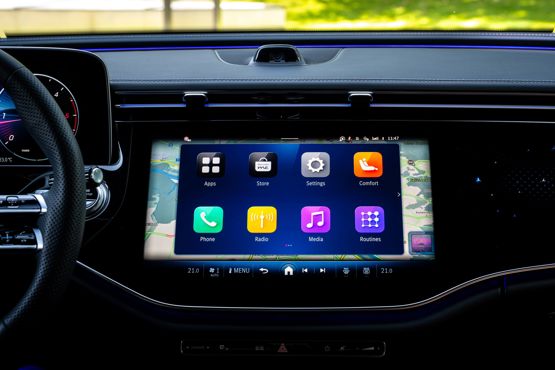
The new E-Class also debuts a new infotainment system for Mercedes. It’s an evolution of the setup found in the C-Class and S-Class, but uses a more advanced computer and includes new functions such as an in-car webcam. Mounted on top of the dashboard, in the centre, the optional camera can be used to make Zoom calls using the car’s in-built 5G connection as well as interacting with social media apps. There's also the option of a screen for the front passenger.
Further enhancements to the infotainment include a Dolby Atmos sound system, by Burmester, that includes in-seat speakers to provide a more immersive and sensory sound experience. It’s an effective system that enables you to ‘feel’ the music. The ambient lighting can also flash along to beat, if you want to turn the E-Class into a mobile nightclub.
A conventional key is no longer required to start the E-Class. Simply pair the car with your smartphone or smartwatch and access will be granted. Speaking of access, the door handles now electrically retract when the car is locked or in motion, like on the S-Class.
When it comes to driveability, the E-Class is still the car that’s better to be driven in than to drive. Mercedes has made changes to the car to enhance its engagement, but if we’re honest these only serve to make it a bit worse than it was before. The steering is a little too eager, making the car change direction fairly drastically with only the smallest inputs. We also felt the throttle pedal calibration made the car a bit too keen to kickdown to a lower gear in some circumstances. A softer approch to the controls would suit the car's nature better.
All the test vehicles available to us were equipped with air suspension and rear-wheel steering, both of which aren’t destined for UK models, so we can’t make definitive driving impressions until we’ve tried a UK-spec example with traditional steel springs.
The cars we did drive exhibited fantastic on-road manners, with a soft and unflustered ride and good body control. We hope these attributes can be engineered into UK models and the additional weight of the E 300e’s larger battery is as well hidden.
Mercedes hasn’t revealed pricing or final specs for the E-Class yet, but it’s likely to start at about £50,000 when it comes to the UK later this year.
It may not be the most dynamic saloon on the market, but the E-Class fits the brief of the executive segment well. For business users, the long-range plug-in hybrid, coupled with all the new technology, make the E-Class a compelling choice.




